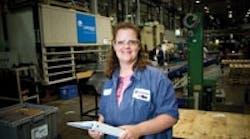To the average person, talk of a workforce shortage probably sounds ridiculous when, according to the Bureau of Labor Statistics, there were 8.5 million Americans out of work in May. That's a full percentage-point increase over the previous year.
But what the everyday Joe probably doesn't realize is that many of the unemployed don't have the necessary skills to fill available positions. So the question for manufacturers is: "How can we unlock the potential from this vast, yet inexperienced, sea of jobless people?" The key could be more in-house training and education and community outreach on behalf of manufacturers.
Cargill Meat Solutions is an example of a manufacturer that has implemented in-house programs to grow its own skilled workforce. In 1993, the business unit of food-processing company Cargill Inc. wanted to provide educational opportunities for a workforce that is 85% Hispanic, with an average education level of the 6th grade. So the company utilized a Federal Workplace Literacy grant and partnered with Morgan Community College to provide English as a Second Language, GED and citizenship classes, according to a recent report from the Manufacturing Institute titled, "Building Tomorrow's Workforce: Promoting the Education & Advancement of Hispanic Immigrant Workers in America."
The report notes that the Hispanic population is expected to account for nearly half of the nation's workforce growth by 2014. According to the report, that means tapping into this largely undereducated influx of immigrants to fill skilled-labor voids will require more employer engagement by:
- Helping workers overcome barriers to education through tuition assistance, rewards for attaining new skills through certification and degrees
- Investing in community college programs by donating equipment or supplies, advising curriculum committees, providing feedback on programs' strengths and weaknesses, and educating other business leaders about the programs
- Educating policymakers by speaking with key elected officials, boards of trustees, and business leaders about the skilled workforce challenge and possible solutions.
| By The Numbers 162 million projected labor force population 26 million expected size of Hispanic workforce by 2014* 382,000 manufacturing employees over the age of 65** 4.4 million manufacturing employees aged 35-44** 4.6 million manufacturing employees aged 45-54** 3.4 million manufacturing employees aged 25-34** Sources: The Manufacturing Institute, |
The current program started in 1997 after a couple failed trials. Cascade first tried to hire homeless people off the street, but that resulted in a high turnover rate. The company then started a "work-to-work" program with a local Burger King owner who would train welfare recipients, providing them with basic job skills before transferring them to manufacturing jobs at Cascade. That didn't work either because the employees were dealing with too many external issues -- such as child care, car care or spousal abuse -- to be reliable, Keller says.
Eventually Cascade discovered a book written by a poverty expert that helped the management team understand the struggles of poverty and class differences. That, combined with the help of an on-site social worker, finally led to success. Now when problems arise the caseworker can help mediate the situation so it doesn't escalate into something more serious.
With a monthly retention rate of 97%, the company has noticed added benefits. "This is a laboratory called Cascade Engineering," says Keller emphatically. "What we have found is that people like being associated with an organization that helps folks, and it doesn't cost us financially other than [the social worker]. So the cost is minimal, and the benefit is that it reinforces positive feelings of why our employees want to work here."
See Also




